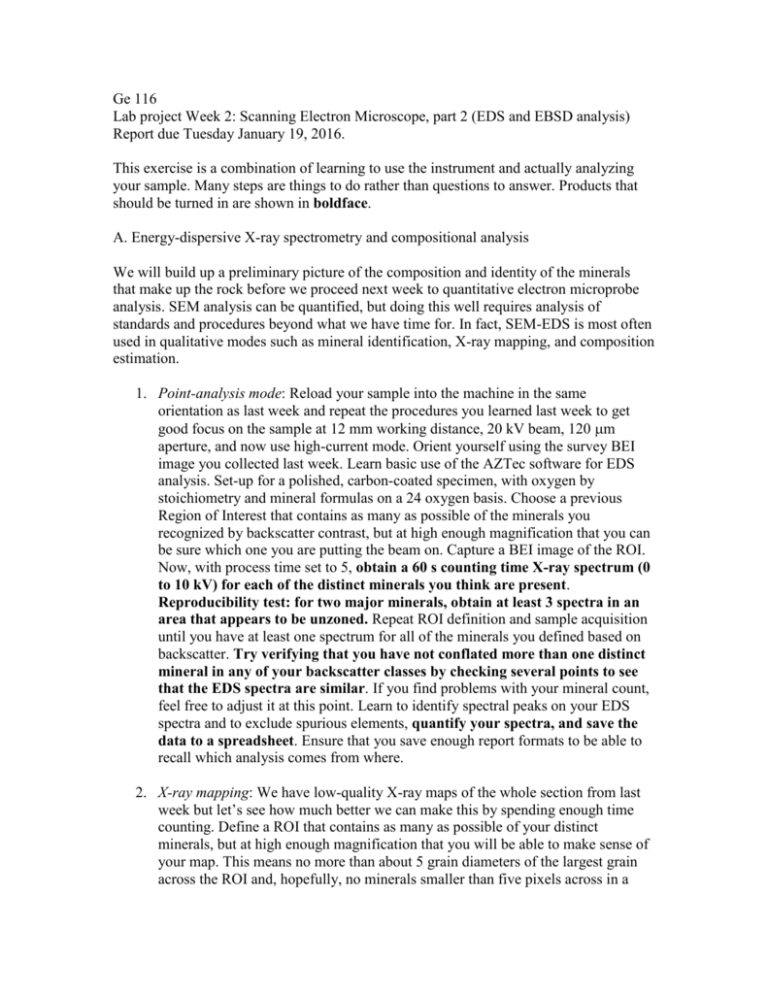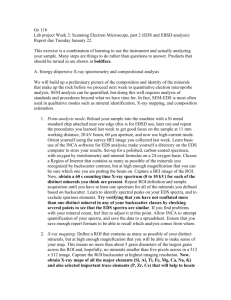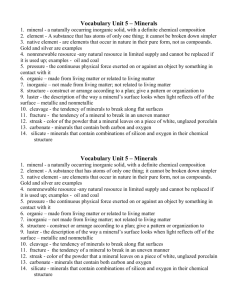Ge 116 - Asimow.com
advertisement

Ge 116 Lab project Week 2: Scanning Electron Microscope, part 2 (EDS and EBSD analysis) Report due Tuesday January 19, 2016. This exercise is a combination of learning to use the instrument and actually analyzing your sample. Many steps are things to do rather than questions to answer. Products that should be turned in are shown in boldface. A. Energy-dispersive X-ray spectrometry and compositional analysis We will build up a preliminary picture of the composition and identity of the minerals that make up the rock before we proceed next week to quantitative electron microprobe analysis. SEM analysis can be quantified, but doing this well requires analysis of standards and procedures beyond what we have time for. In fact, SEM-EDS is most often used in qualitative modes such as mineral identification, X-ray mapping, and composition estimation. 1. Point-analysis mode: Reload your sample into the machine in the same orientation as last week and repeat the procedures you learned last week to get good focus on the sample at 12 mm working distance, 20 kV beam, 120 m aperture, and now use high-current mode. Orient yourself using the survey BEI image you collected last week. Learn basic use of the AZTec software for EDS analysis. Set-up for a polished, carbon-coated specimen, with oxygen by stoichiometry and mineral formulas on a 24 oxygen basis. Choose a previous Region of Interest that contains as many as possible of the minerals you recognized by backscatter contrast, but at high enough magnification that you can be sure which one you are putting the beam on. Capture a BEI image of the ROI. Now, with process time set to 5, obtain a 60 s counting time X-ray spectrum (0 to 10 kV) for each of the distinct minerals you think are present. Reproducibility test: for two major minerals, obtain at least 3 spectra in an area that appears to be unzoned. Repeat ROI definition and sample acquisition until you have at least one spectrum for all of the minerals you defined based on backscatter. Try verifying that you have not conflated more than one distinct mineral in any of your backscatter classes by checking several points to see that the EDS spectra are similar. If you find problems with your mineral count, feel free to adjust it at this point. Learn to identify spectral peaks on your EDS spectra and to exclude spurious elements, quantify your spectra, and save the data to a spreadsheet. Ensure that you save enough report formats to be able to recall which analysis comes from where. 2. X-ray mapping: We have low-quality X-ray maps of the whole section from last week but let’s see how much better we can make this by spending enough time counting. Define a ROI that contains as many as possible of your distinct minerals, but at high enough magnification that you will be able to make sense of your map. This means no more than about 5 grain diameters of the largest grain across the ROI and, hopefully, no minerals smaller than five pixels across in a 1024 x 1024 image. In AZTec, capture the ROI backscatter image with good focus, contrast and brightness. Now, obtain X-ray maps of all the major elements (Si, Al, Ti, Fe, Mg, Ca, Na, K) and also selected important trace elements (P, Zr, Ce) that will help to locate common trace minerals. If you’ve seen any other peaks that got your attention in any of your point analyses, you can add those to your mapping too. Collect your maps in continuous acquisition mode and continue until the quality does not seem to be improving anymore (but not more than 30 minutes of acquisition). Now select TruMap to remove some background, peak overlap, and peak pile-up errors. Choose which elements to include in the EDS Layered image and adjust color choices and brightness/contrast to make your Layered image as attractive, informationrich, and useful as possible. 3. Interpretation (i.e. do this part after you are done with the machine): Transfer your data (Excel spreadsheets, Word reports with images, and full-resolution export of the EDS layered image) to your own computer. There are many questions we can ask of this data. Let’s start with these: Use your X-ray maps to check your mineral list based on backscatter contrast. Can you locate any trace phases that you missed before? Are there minerals that you found to have similar backscatter but are compositionally quite distinct? Are there minerals that you judged to have distinct backscatter but are compositionally similar? How large are the errors on your measurements (one standard deviation) and given these errors are there any common minerals that you might not be able to tell apart? Is there zoning in any of the phases, and how does your impression of zoning based on the X-ray maps differ from your impression based on backscatter contrast? Update your list of minerals again, if necessary. Now, in a table of your point analyses, attempt to identify all your minerals based on composition, stoichiometry, and petrological insight; group analyses of similar phases (note, it is not necessarily possible to do this completely and accurately, for many reasons: the EDS analysis is only semi-quantitative; composition is never enough to actually identify a mineral, you need structural information; etc.). B. Electron Backscatter Diffraction (EBSD) Our SEM is equipped with a powerful tool for interrogating crystal lattice information, for purposes of mineral identification and orientation, called EBSD. We will attempt a basic introduction to EBSD here. 1. Reconfigure the machine for EBSD measurement (20 kV, 120m aperture, high current): remove the RBSD if you are using it, switch channels to the forward-scatter detector, carefully tilt the sample to 70°, then insert the EBSD detector to a suitable analysis position. Do these steps carefully – it is possible to run parts into other parts and destroy them (your professor has done so). Now, carefully, move your sample into position to image the ROI from exercise A1 above and obtain good focus on the center-line of the image. Turn on tilt-correction to obtain an apparently flat image, and tune Dynamic Focus to try to get top and bottom in focus at the same time. 2. Switch the AZTec software to EBSD mode: Capture the BSE image. Do a background correction in AZTec before focusing on a single crystal. Search the mineral libraries and add to the list of minerals to be considered any that you think you have identified in your sample based on composition. 3. Interactive operation: Go through your list of minerals, and attempt to capture a good quality Kikuchi pattern on each one. See if the software can index it, and see whether the indexing matches your preliminary identification of the mineral. You may need to try manual picking of Kikuchi bands and see whether you can pick bands better than the computer. Adjust the list of minerals considered until you find that the great majority of single points can be successfully indexed. If you can get good apatite patterns, try to compare the pattern for a crystal that appears as an equant hexagon and one for a crystal that appears an elongated rod. 4. IF TIME ALLOWS Mapping operation: Now, in automatic mode, define an area scan and capture an EBSD map of your ROI. Adopt a suitable compromise between resolution and collection time so that you get the highest quality map whose acquisition can be completed by the end of your allotted lab time. 5. IF TIME ALLOWS Output reports: Using the EBSD software, reduce your data to maps of indexed mineral identification and, for the major minerals, orientation. Generate pole figures of lattice orientation for at least one major mineral. 6. Shutdown: Withdraw the EBSD detector, retrieve your sample, return the stage to 0° tilt, and standby the machine properly. Transfer your data reports to your own computer. 7. Interpretation (i.e. offline tasks): Make any adjustment to your backscatter-and-EDS-based mineral identification list required by the EBSD data. IF TIME ALLOWED GATHERING MAP DATA, examine the orientation maps and pole figures and assess whether your sample has a Lattice Preferred Orientation. If so, how does it compare to any Shape Preferred Orientation identified by BEI imaging? C. Synthesis You now have collected all the major types of information about your sample that are obtainable with a field-emission scanning electron microscope. In particular, you have a list of identified minerals and some sense of their composition, texture, and distribution. From your backscatter, X-ray, and EBSD maps, estimate the volumetric proportion of each mineral in the bulk rock. Finally, using these mineral identifications and abundances, name your rock (review rock naming in any igneous petrology textbook; your answer should define the mafic minerals present and the formal classification based on Q-A-P-F-M abundances).










